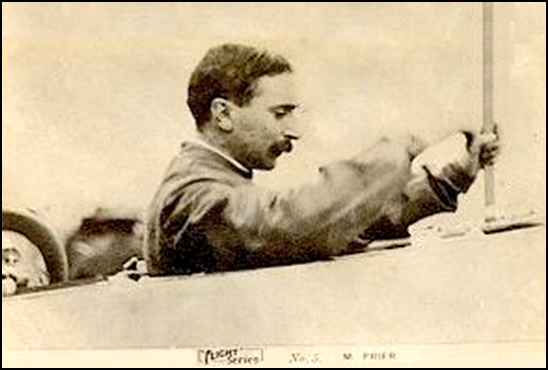
1886-1950 |
 |
Pierre Prier Collection of Catherine Evans, 7-21-06 |
via email from Janine Prier, 3-8-09 En réponse à votre recherche sur Pierre PRIER ( mon père), voici ses dates de naissance et décès : 26 Décembre 1886 à Rouen (Seine Maritime) 30 Juin 1950 à Neuilly-sur-Seine (Hauts de Seine) Mon père a fait ses études classiques au Lycée Corneille à Rouen, puis, à Paris, à l'Ecole Violet (électricité). Après la guerre de 14-18, il a dirigé la Société de Liquidation des Stocks de l'Aviation. En 1927 (année de ma naissance), il a été l'un des fondateurs de la Socièté Continentale PARKER qui exploitait, en France et en Europe, les brevets de la Parker Westproof Company de Détroit : il s'agissait de la "parkerisation" et des traitements de surface des métaux qui en découlaient. Il a dirigé cette société jusquà sa mort en 1950. Son petit-fils Pierre Prier est Grand Reporter au "FIGARO" et éqalement pilote. Dear Sir, In response to your search on Pierre PRIER,(my father), here are the dates of birth and death: 26 December 1886 in Rouen (Seine Maritime) 30 June 1950 in Neuilly-sur-Seine (Hauts de Seine) My father did his classical studies at the Lycée Corneille in Rouen, and then in Paris at the Ecole Violet (electricity). After the war of 14-18, he led the Company to liquidate stocks of Aviation. In 1927, (the year of my birth), he was a founder of Continental Park which operated in France and Europe, patents Westproof of the Parker Company of Detroit: it was the "parkerisation and surface treatment of metals arising. He led the company until his death in 1950. His little son is Pierre Prier, a Reporter at Large for "FIGARO" and also a pilot. |
via email from Dave Lam, 10-27-06 He worked as pilot instructor at the Bleriot School at Hendon in the United Kingdom. He made the first nonstop flight between London and Paris in a Bleriot on 12 April 1911, flying 4 hours 55 minutes. He actually flew between Hendon and Issy-les-Moulineaux. He volunteered during the first world war, and convoyed many aircraft from Voisin and Nieuport to the combattant units. Dave |
|
via email from Jon Putnam, 2-5-05 Prier’s first design was the P-1, also known as the No. 46. Prier designed the P-1 as a fast, single-seat monoplane to compete in the annual Gordon Bennett Cup Race in July and the 1911 Circuit of Britain Race (need the 1911 date). The P-1 had a 50hp Gnome engine, Bleriot-type wing-warping, and undercarriage with spring skids, and a balanced rudder and stabilizer with no fixed surfaces. It was designed to go 70 mph which it achieved. Unfortunately, the P-1 was not completed in time for the Gordon Bennett Cup and was smashed on the morning of the start of the Circuit of Britain and so did not compete in the race. Prier then redesigned the P-1. According to Flight, “the machine is exceedingly quick on the controls owing to the fact that she has a balanced rudder and elevator, so giving enormous power with very little effort. Besides this, there is no fixed empennage, and so no “damping” effect, except what is provided by the covered-in fuselage, and the said fuselage itself is very short, so every control is very quick. Of course, for men with slow hands, it will not be easy to damp down this quickness of action but men of Prier’s class prefer the maximum of control in their own hands. When one comes to inspect the machine at close quarters one has more respect for it still, because its strength of construction must be enormous compared with some of the continental machines. The engine housing and method of fixing it is very strong indeed, and the fuselage is built throughout without piercing the longitudinals, the cross-pieces being held in position by steel flitch-plates, to which tension wires are fixed. Prier has fitted double control-wires all over the machine and the rudder and elevator levers are steel plate instead of aluminum, as in some foreign machines. In fact, the whole construction is bound to give confidence. I gather that when this machine has quite satisfied its proprietors, it is to be followed by a bigger two-seater on similar lines, and such a machine will be just the thing we want for military purposes.” Later versions of the Bristol Prier Monoplane did include single and two-seat versions which were widely used in flying schools in the UK, Spain, Germany, and Italy and by the military in several countries. |
|
via email from Nick Forder, 4-15-04 1911 Worked at Bleriot School, Hendon, as a mechanic. 27.7.1911 Awarded Ticket 99, following a course of instruction with Pierre Prier, Chief Instructor at the Bleriot School at Hendon. 1911 Succeeded Prier as Chief Instructor at Bleriot School, Hendon |
|
"The first nonstop flight from London to Paris came less than two years after Blériot’s Channel crossing. It was made by Pierre Prier (chief flight instructor at the Blériot School, Hendon, England), flying a 50-hp Gnome-powered Blériot monoplane that completed the trip in 3 hr 56 min. Prier departed from Hendon and landed at Issy-les-Moulineaux." In addition to searching the web, you should search the Book search section. You will find numberous links to mentions of his name in various books. |
|
If time permits, I recommend that you visit the homesite and sample some of the many interesting offerings, especially those in the "Aviation Items" section. |
|
|
|
If you have any more information on this pioneer aviator please contact me. E-mail to Ralph Cooper |


|